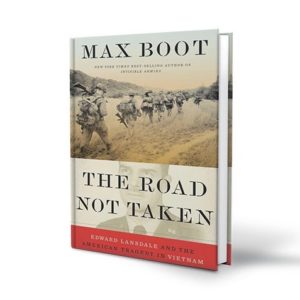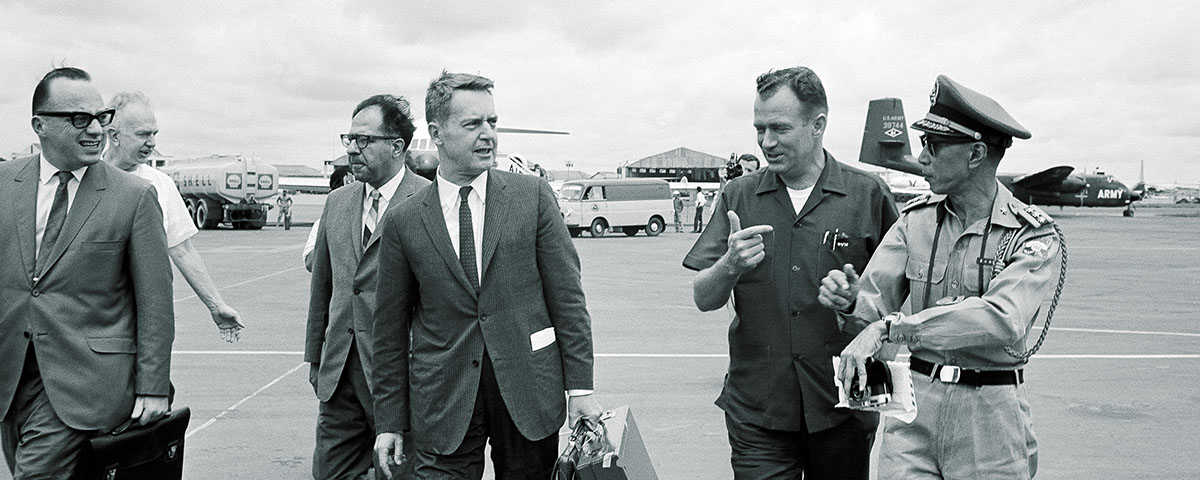Could Ed Lansdale have won the Vietnam War if U.S. leaders had just listened to him and followed his advice? That’s the intriguing question that Max Boot’s nearly 800-page biography raises about one of the war’s most controversial and fascinating figures. And that question seems genuine—not publicity-hyping hyperbole.
Lansdale, an Air Force colonel attached to the CIA, arrived in Saigon in 1954 as a burgeoning communist insurgency was spreading throughout South Vietnam while the defeated French colonial regime was packing up to leave.
He had already been instrumental in engineering the defeat of another Asian communist guerrilla insurgency, the Philippines’ Hukbalahap movement.
 During assignments in Manila in 1945-48 and 1951-53, Lansdale—a former civilian advertising executive and self-taught counterguerrilla strategist—managed (nearly single-handedly, according to Boot) to persuade the Philippines’ leadership to institute sweeping reforms that robbed the Huk insurgency of Filipino peasants’ support while simultaneously strengthening government control of the population.
During assignments in Manila in 1945-48 and 1951-53, Lansdale—a former civilian advertising executive and self-taught counterguerrilla strategist—managed (nearly single-handedly, according to Boot) to persuade the Philippines’ leadership to institute sweeping reforms that robbed the Huk insurgency of Filipino peasants’ support while simultaneously strengthening government control of the population.
Key to Lansdale’s success in instituting and promoting that anti-Huk campaign was his ability to forge close personal relationships with senior Filipino leaders, notably defense minister and later president Ramon Magsaysay (for whose 1953 presidential campaign and victory, Boot claims, Lansdale fully deserves credit).
But all insurgencies are not the same, and Vietnam in 1954 was not the Philippines in 1951. As he did with Magsaysay, Lansdale developed a personal bond with South Vietnam’s leader, Ngo Dinh Diem, but he lacked the intimate, personal knowledge of Vietnamese culture, history, geography and politics—the type of background he had gained in the Philippines from many years there (and, not incidentally, through a long relationship with his Filipina paramour, Pat Kelly, who was not merely Lansdale’s lover but also his partner in the Philippines’ counterguerrilla efforts).
Despite Lansdale’s superb skill in building trust and mutual respect with Filipino and Vietnamese leaders, he managed to antagonize nearly everyone he encountered in the U.S. government, including his own superiors in the military, CIA, State Department and other agencies. Lansdale may have been a true visionary in counterinsurgency campaigns, but he proved to be woefully inept in his attempts to cultivate high-level support for his groundbreaking strategy.
Lansdale rightfully deserves credit for recognizing Diem as the only South Vietnamese leader capable of rallying strong popular support for the nascent democracy’s central government as it battled the Hanoi-directed communist insurgency. Indeed, Lansdale’s support enabled Diem to survive several coup attempts during the 1950s and early ’60s. But Lansdale was tragically unable to prevent his own government from engineering the 1963 coup in which Diem was assassinated.
However, the central question remains: Could Lansdale’s roadmap for victory, with its emphasis on counterinsurgency campaigns, have led to a better result in Vietnam?
The answer is a definite and unequivocal “no.” Lansdale’s “road not taken” could not have won the war. A “yes” answer would be predicated upon the demonstrably false assumption that South Vietnam fell to a communist-led guerrilla insurrection supported by the masses, who rose up and overthrew the Saigon government—Mao Zedong’s famous “third phase” of classical guerrilla warfare. That, of course, did not happen.
As early as 1966, with the guerrilla movement in South Vietnam faltering, North Vietnam sent men southward to begin replacing its dangerously depleted guerrilla cadres with troops from the regular army. And after the failed 1968 Tet Offensive nearly eradicated the remaining Viet Cong units and revolutionary leaders in the South, the Politburo in Hanoi simply changed its warfighting strategy—opting to prosecute the war through a naked, overpowering invasion of South Vietnam led by North Vietnamese Army troops.
Although the North would still use guerrilla tactics to avoid the overwhelming firepower of U.S. and South Vietnamese forces, Hanoi’s military effort was no longer based on classic guerrilla war strategy. There would be no more attempts at a popular uprising to overthrow the Saigon government.
When the communist strategy shifted toward conventional battlefield confrontations, Lansdale’s “counterinsurgency” strategy was rendered irrelevant.
The communist attacks in the 1972 Easter Offensive failed miserably in the face of U.S. air power and massive logistical support for South Vietnam. But once the U.S. abandoned the Republic of Vietnam in 1973, Hanoi persevered with that strategy and rolled over the country’s defenders in April 1975 with a massive invasion of tanks, artillery and infantry.

